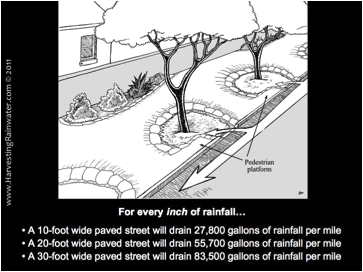 |
|
Water CollectionDon't let the rain water be wasted away in sewers. Use it for good! Roof CollectionRoofs are excellent for harvesting rainwater for use in landscape irrigation as well as for collecting drinking water.  Image courtesty of Brad Lancaster The components of a rainwater collection system include the sloped roof, gutters, a leaf and first flush diverter (keeps dirt from the first rains from entering the tank), collection tank, pump (if needed) and irrigation system. A simple rain barrel filled from roof runoff is an important educational tool as part of understanding the water cycle and for discussing the need for protecting water and air from pollution Landscape CollectionThe key concepts of landscape water are Slow It, Spread It and Sink It. Allowing rainwater that falls onto your landscape to sink into the earth makes it available for plants and trees, cleans it as it passes into aquifers and waterways and reduces the need for construction and maintaining rainwater runoff infrastructures.  Image courtesty of Brad Lancaster Earth that has mulch and a high organic matter content works like a sponge and soaks up rainwater. Landscapes should be sculpted so that there are low slopes so that water stands or travels slowly. Terraces or swales contain and spread the rainwater and run-off so that it can seep into the ground.  Image courtesty of Brad Lancaster Slowing water speed along the landscape reduces loss of topsoil and therefore maintains soil fertility and structure. Sidewalk and Roadway CollectionSidewalks and roadways normally lead rainwater to underground gutters take the rain away. In natural systems this resource would be collected by the earth to promote growth. Instead of high maintenance grassy patches commonly found along sidewalks, why not use the water to irrigate shade and fruit trees for the commons?  Image courtesty of Brad Lancaster How? Dig out the raised islands and plant trees and shrubs in indentations along roads and sidewalks. In Arizona cities now cut curbs to allow rainwater to flow into these 'planters'.  Image courtesty of Brad Lancaster Trees alongside sidewalks, roads and bike paths provide shade during hot summer days and make a cool pathway that supports outdoor exercise. When planted with trees that are native to the region, these systems become habitats for birds and animals that have been forced out of the sub/urban landscape. Some communities choose fruit-bearing trees and harvest them in seasonal festivals.  Image courtesty of Brad Lancaster Resources:
Contact Lotan Center for Creative Ecology |
|
|

